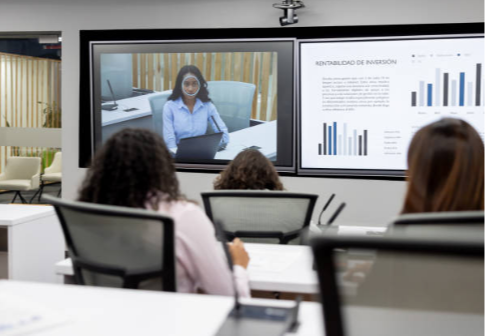
Facial recognition heads to class. Will Students Benefit From Facial Recognition?
In an era where technology rapidly infiltrates every facet of our lives, facial recognition has emerged as one of the most intriguing and controversial innovations. Initially lauded for its applications in security, law enforcement, and personal convenience, this sophisticated technology is now making its way into educational institutions. From improving campus security to streamlining administrative processes, the promise of facial recognition in schools and universities is tantalizing.
Yet, as with any technological advancement, its introduction into the educational environment raises critical questions. Can facial recognition genuinely enhance the student experience, or does it simply open the door to new privacy concerns and ethical dilemmas? In this blog post, we delve into the multifaceted implications of facial recognition in the classroom. We'll explore the potential benefits, such as increased safety and personalized learning, alongside the challenges and controversies that accompany its use.
Join us as we navigate this complex landscape, evaluating whether facial recognition technology truly has a place in the future of education and, more importantly, if students stand to gain from its adoption.
What is Facial Recognition?

Facial recognition technology represents a remarkable leap in the field of biometric identification. At its core, facial recognition involves the use of advanced algorithms to map and analyze human facial features. By capturing and comparing these features, the system can identify or verify an individual’s identity with impressive accuracy.
Definition and Basic Explanation
Facial recognition can be defined as a biometric software application capable of uniquely identifying or verifying a person by comparing and analyzing patterns based on the person's facial contours. Unlike other biometric systems that rely on fingerprints or iris scans, facial recognition utilizes the distinct and complex landscape of the human face. Each person's face has a unique structure, including the distance between the eyes, the shape of the cheekbones, and the contour of the lips, which the technology meticulously analyzes to create a digital representation known as a "faceprint."
How Facial Recognition Works
The process begins with image acquisition, where a camera captures a photo or video frame of the person’s face. This image is then converted into a digital format that can be processed by facial recognition software. The software maps out facial features, creating a mathematical representation based on key points, often referred to as landmarks. These landmarks might include the position of the eyes, the length of the nose, and the shape of the mouth.
Next, the software compares the captured faceprint against a database of known faceprints. This database could range from a school’s student records to a more extensive repository used by law enforcement agencies. The comparison involves sophisticated algorithms that analyze the faceprint's geometry and other characteristics, searching for a match.
When a match is found, the system can identify the individual with a high degree of confidence. If used for verification, the technology confirms whether the person is who they claim to be by comparing the live image with a pre-existing image. This seamless and often instantaneous process allows facial recognition to be employed in a wide range of applications, from unlocking smartphones to enhancing security protocols in sensitive environments.
In the context of education, facial recognition technology can streamline various administrative tasks, improve security, and even customize learning experiences, but its implementation also necessitates a careful consideration of privacy and ethical concerns.
Facial Recognition in Education: Potential Applications in an Educational Setting
As facial recognition technology continues to advance, its potential applications in education are becoming increasingly apparent. Schools and universities are exploring ways to integrate this technology to enhance security, streamline administrative tasks, and personalize learning experiences. Here are some potential applications of facial recognition in educational settings:
Enhanced Security and Safety
One of the primary benefits of facial recognition in schools is its ability to significantly enhance security. By quickly and accurately identifying individuals as they enter and exit school premises, this technology can help prevent unauthorized access and ensure that only students, staff, and authorized visitors are allowed on campus. In the event of an emergency, facial recognition can provide real-time information on the location of students and staff, aiding in more efficient evacuations and safety procedures.
Streamlined Attendance Tracking
Traditional methods of taking attendance, such as roll calls or sign-in sheets, can be time-consuming and prone to errors. Facial recognition can automate this process, instantly recording student attendance as they enter the classroom. This not only saves valuable instructional time but also provides more accurate and reliable attendance data. Additionally, it can help identify patterns of absenteeism and tardiness, enabling educators to address these issues proactively.
Learn more here: Face Recognition Attendance System
Personalization of Learning Experiences
Facial recognition can also be used to personalize learning experiences. By tracking student engagement through facial expressions and emotions, educators can gain insights into how students are responding to different teaching methods and materials. This data can help teachers tailor their instruction to better meet individual student needs, fostering a more effective and responsive learning environment. For example, if a student appears confused or disengaged during a particular lesson, the teacher can intervene and provide additional support.
Efficient Resource Management
Libraries, cafeterias, and other school facilities can benefit from facial recognition technology as well. For instance, in the library, facial recognition can streamline the checkout process, allowing students to borrow books without the need for library cards or manual entry. In the cafeteria, it can facilitate cashless transactions, making lunchtime operations faster and more efficient. This technology can also monitor the use of school resources, ensuring that they are being utilized effectively and responsibly.
Monitoring and Enhancing Student Well-being
Beyond academics, facial recognition can play a role in monitoring student well-being. By observing changes in a student's facial expressions and behavior over time, the technology can potentially identify signs of stress, fatigue, or emotional distress. This information can prompt timely interventions by counselors or mental health professionals, supporting a holistic approach to student welfare.
Simplifying Access Control
Facial recognition can simplify access control to various parts of the school, such as laboratories, sports facilities, and dormitories. By eliminating the need for physical keys or access cards, the technology not only enhances security but also reduces the administrative burden associated with managing and distributing access credentials.
Real Case Studies and Examples of using Facial Recognition

One notable example is Shenzhen Experimental School in China. This school has adopted facial recognition technology to monitor classroom behavior and student engagement. Cameras installed in classrooms capture students' facial expressions, helping teachers understand their levels of concentration and interest in real-time. This data allows educators to adjust their teaching methods to better suit the needs of their students, ultimately fostering a more effective learning environment.
In the United States, Lockport City School District in New York has implemented a facial recognition system to enhance campus security. The system scans faces at building entrances and matches them against a database of individuals who are either authorized or flagged as potential threats. This proactive approach aims to prevent unauthorized access and ensure the safety of students and staff.
Deakin University in Australia is another institution that has embraced facial recognition technology. Here, facial recognition is used to automate attendance tracking in large lecture halls. Students' faces are scanned as they enter the room, and their attendance is automatically recorded. This not only saves time but also provides accurate attendance data that can be used to identify students who may need additional support.
The implementation of facial recognition at Shenzhen Experimental School has yielded several positive outcomes. Teachers report that they can more effectively gauge student engagement and adjust their teaching strategies accordingly. This has led to improved student participation and better overall academic performance. Additionally, the technology has helped reduce instances of cheating during exams, as it monitors student behavior more closely.
Lockport City School District has seen significant improvements in campus security since the introduction of facial recognition. The system has successfully prevented unauthorized individuals from entering school premises, thereby reducing potential security threats. Parents and staff have expressed increased confidence in the safety measures, contributing to a more secure learning environment.
At Deakin University, the automated attendance system has been well-received by both students and faculty. The technology has streamlined the attendance-taking process, allowing lecturers to focus more on teaching and less on administrative tasks. Students appreciate the convenience, as they no longer need to manually sign in. The accurate attendance data has also enabled the university to identify students who may be struggling with attendance and provide timely support.
Privacy Concerns and Ethical Considerations

While facial recognition technology offers numerous benefits in educational settings, it also raises significant privacy and ethical concerns. As schools and universities integrate this technology, it is crucial to address these issues comprehensively to ensure the protection of student rights and well-being.
Data Privacy Issues
One of the foremost concerns with facial recognition technology is the handling of sensitive biometric data. Facial recognition systems collect, store, and analyze detailed information about individuals' facial features. This data, if not properly secured, can be vulnerable to breaches and unauthorized access. The potential for data theft raises serious concerns about privacy and security, as leaked biometric data could be misused in various harmful ways.
To mitigate these risks, educational institutions must implement robust data protection measures. This includes employing advanced encryption techniques, securing databases, and ensuring that only authorized personnel have access to the stored data. Regular audits and compliance with data protection regulations, such as the General Data Protection Regulation (GDPR) or the Family Educational Rights and Privacy Act (FERPA), are also essential to maintaining the integrity of biometric data.
Consent and Student Rights
The deployment of facial recognition technology in schools necessitates clear policies regarding consent and student rights. Students and their parents or guardians should be fully informed about how the technology works, what data is being collected, and how it will be used. Obtaining explicit consent before collecting biometric data is a critical ethical requirement.
Educational institutions must ensure that participation in facial recognition systems is voluntary and that there are opt-out options available without penalty. Transparent communication about the purpose and scope of data collection, as well as the duration of data retention, helps build trust and respect for student privacy. Moreover, institutions should establish clear guidelines on how students can access and request the deletion of their biometric data if they choose to do so.
Potential for Misuse and Abuse
The potential for misuse and abuse of facial recognition technology is another significant ethical concern. Without stringent oversight, there is a risk that the technology could be used for purposes beyond its intended scope, such as unwarranted surveillance or discriminatory practices. For example, there have been instances where facial recognition systems have shown biases, particularly against certain ethnic groups, raising concerns about fairness and equity.
To prevent misuse, educational institutions must establish strict usage policies and oversight mechanisms. This includes defining clear boundaries for the application of facial recognition, ensuring that it is used solely for enhancing security and educational outcomes, and not for monitoring students' every move. Independent oversight committees can play a crucial role in ensuring that the technology is used ethically and that any instances of misuse are promptly addressed.
Impact on Student Behavior and Mental Health
The pervasive presence of facial recognition technology in educational settings can also impact student behavior and mental health. The knowledge that they are constantly being monitored may lead to feelings of anxiety, stress, and a loss of autonomy. Students might alter their behavior unnaturally, leading to a less authentic and engaging learning environment.
Educational institutions must consider these psychological impacts when implementing facial recognition systems. It is essential to create a balanced approach that respects students' need for privacy while leveraging the benefits of the technology. Schools can foster a supportive environment by encouraging open discussions about the use of facial recognition, addressing student concerns, and ensuring that the technology is applied in a way that enhances rather than detracts from the educational experience.
Legal and Regulatory Landscape of using Facial Recognition Technology
As facial recognition technology becomes more prevalent in educational institutions, navigating the legal and regulatory landscape is crucial. Different regions have varying laws and regulations governing the use of biometric data, and schools must ensure compliance to protect student privacy and rights.
Existing Laws and Regulations Regarding Facial Recognition in Schools
In many countries, the use of facial recognition technology in schools is governed by laws that protect individual privacy and regulate the collection and use of biometric data. In the United States, for example, the Family Educational Rights and Privacy Act (FERPA) plays a significant role. FERPA protects the privacy of student education records and grants parents and eligible students the right to access and control their personal information. Schools must ensure that any data collected through facial recognition is stored securely and that parents and students are informed about how their data is being used.
Additionally, some states have enacted specific laws regarding biometric data. The Illinois Biometric Information Privacy Act (BIPA) is one of the most stringent, requiring organizations to obtain explicit consent before collecting biometric data and to outline how the data will be used, stored, and destroyed. Schools in Illinois using facial recognition technology must adhere to these regulations to avoid legal repercussions.
In the European Union, the General Data Protection Regulation (GDPR) sets a high standard for data protection and privacy. Under GDPR, biometric data is classified as sensitive personal data, requiring schools to obtain explicit consent from students or their guardians before collection. Schools must also demonstrate that the use of facial recognition technology is necessary and proportionate to the intended purpose, and they must implement strict data protection measures.
Regional Differences and International Perspectives
The approach to regulating facial recognition technology in schools varies significantly around the world. In some regions, there is a more cautious stance, with strict regulations and a high emphasis on privacy protection. In others, the adoption of facial recognition is more permissive, with fewer regulatory hurdles.
For instance, China has been a frontrunner in adopting facial recognition technology across various sectors, including education. Chinese schools have implemented facial recognition for attendance tracking, monitoring student behavior, and enhancing security. While the technology is widespread, it has also sparked debates about privacy and surveillance, with concerns over the extent of data collection and usage.
In contrast, the European Union has taken a more conservative approach, with stringent regulations under GDPR. European schools must conduct data protection impact assessments before implementing facial recognition systems and ensure that they comply with the principles of data minimization and purpose limitation.
In the United States, the regulatory landscape is fragmented, with different states adopting varying levels of regulation. While some states like Illinois have comprehensive biometric data protection laws, others have yet to establish specific regulations, leading to inconsistencies in how facial recognition technology is implemented and governed in schools.
Internationally, countries like Australia and Canada are also grappling with the balance between leveraging facial recognition technology and protecting individual privacy. In Australia, the use of biometric data is regulated under the Privacy Act 1988, which requires organizations, including schools, to handle personal information responsibly and transparently. Canada’s Personal Information Protection and Electronic Documents Act (PIPEDA) similarly sets out guidelines for the collection, use, and disclosure of personal information, including biometric data.
As facial recognition technology continues to evolve, the legal and regulatory landscape will likely adapt in response to new challenges and societal attitudes toward privacy and security. Schools and educational institutions must stay informed about current laws and best practices to ensure they comply with regulations and protect the rights of their students. By navigating these legal complexities carefully, schools can responsibly harness the benefits of facial recognition technology while upholding the highest standards of privacy and ethical conduct.
Conclusion
As facial recognition technology finds its way into classrooms around the world, it brings with it a mix of potential benefits and significant challenges. From enhancing security and streamlining administrative processes to personalizing learning experiences, the technology offers a range of advantages that could revolutionize educational settings. However, it also raises critical issues around privacy, consent, ethical use, and the impact on student behavior and mental health.
The successful implementation of facial recognition in schools requires a balanced approach that considers the viewpoints of all stakeholders, including students, parents, educators, and the broader community. Addressing privacy concerns and ethical considerations is paramount, as is ensuring compliance with existing laws and regulations. Transparent communication and the establishment of clear policies are essential to gaining trust and support.
Real-world examples have shown both the promise and pitfalls of this technology. Schools that have adopted facial recognition report improvements in security and efficiency, but they also face scrutiny and opposition from those wary of its implications. The varied responses highlight the need for careful, thoughtful deployment, with robust safeguards to protect individual rights and data.
As the conversation around facial recognition in education continues to evolve, ongoing dialogue, research, and community engagement will be crucial. By staying informed and adaptive, educational institutions can responsibly harness the benefits of this technology while upholding the highest standards of privacy, security, and ethical conduct.
In the end, the question remains: will students truly benefit from facial recognition in their educational journey? The answer lies in our collective ability to navigate the complexities, address the concerns, and ensure that the technology serves to enhance, rather than hinder, the learning experience.
